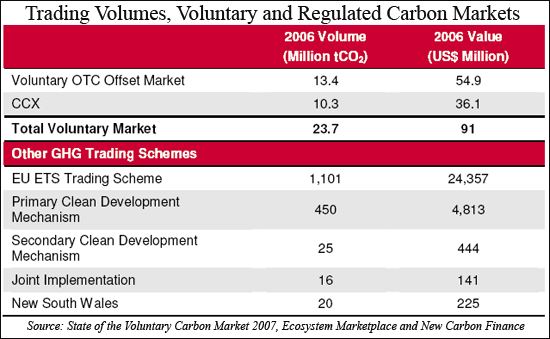The growing voluntary carbon market
Though voluntary carbon markets have effectively been operating since 1989, quantitative data surrounding this market has been lacking, say analysts Ecosystem Marketplace and New Carbon Finance. The groups sought to address this with a wide ranging survey with responses from over 70 organizations involved all stages of the carbon offset supply chain covering five continents.
The results show that, like the early stages of the regulated carbon markets of the European Union’s Emissions Trading Scheme (EU ETS) and the Kyoto Protocol, the voluntary markets are evolving rapidly. They also show that 2006 was a year of significant growth with many new retailers, brokers, and other actors entering the market.
Since 2002 the number of organizations supplying carbon credits into the market has grown by 200%, with online retailers being the fastest growing sector of the marketplace.
In 2006 23.7 million tons of carbon dioxide equivalents (MtCO2e) were transacted in the voluntary carbon markets. Of this, 10.3 MtCO2e were transacted on the Chicago Climate Exchange, a voluntary but legally binding cap-and-trade system whose participants include many leading corporations.
The remaining 13.4 MtCO2e were transacted in the Over the Counter (OTC) market, which consists of individual purchasers and vendors operating without binding regulations or obligations.
Based on these estimates, the value of the voluntary carbon market nearly tripled from 2005 to 2006. CCX market volume grew by 610% and the voluntary OTC market grew almost 80% from a year earlier.
Because it is impossible to capture all OTC transactions in a survey such as this, the report indicates the actual volume traded may be considerably larger. The World Bank’s State of the Carbon Market 2007 (PDF) report estimated the value of the voluntary market at US$100 million in 2006.

Much of the demand driving the voluntary carbon markets comes from the developed and more environmentally aware markets in North America and Europe. Survey respondents reported that 68% of their customers are based in the United States and 3% in Canada.
In addition, about half of the responding suppliers were based in the U.S, and roughly 43% of carbon offsets sold in the OTC market were sourced from North American-based projects. Europe was also a major source of market demand and supply in the market, with 28% of the survey respondents’ customers based in the EU and a little over 30% of suppliers based in the EU. About 10% respondents were based in Australia.
Businesses were the largest buyers (by volume) in this market, but contrary to some expectations, anticipation of future regulation did not appear to be the main motivation for purchases. According to buyers surveyed, their main motivations for participation in the market were corporate social responsibility and to “walk the talk” in terms of environmental stewardship.
Overall, the OTC market is dominated by three types of projects: forestry sequestration (36%), renewable energy (33%), and industrial gases (30%).
The volume-weighted average price of carbon on these markets was US$4.1 per tonne of CO2e, although transactions occurred for a vast range of prices: from US$0.45 to US$45 per tonne. Within this range the highest prices were paid for projects with strong quality and verifiability attributes, such as landfill methane and coal mine methane, as well as the more publicly visible forestry projects and long term sustainable development projects, such as energy efficiency and off-grid renewable energy.
More respondents cited selling offset credits sourced from micro projects, generating less that 5,000 tCO2e, than any other project type. Around 36% of offset credits in the OTC market were sourced from projects less than 100,000 tCO2e. This provides greater opportunities for voluntary markets to contribute to sustainable development in smaller communities.
Read the full report, State of the Voluntary Carbon Market 2007: Picking up Steam (PDF).
The voluntary carbon market can serve as an important testing ground for both regulators and participating businesses. The carbon offset market is currently experiencing a number of challenges as it grows, including issues related to quantifying, verifying and certifying claimed emissions reductions. There is an urgent need for a credible standard to provide reliability and trust in the market, as many international organizations and financial bodies have called for.
However, as this report from Ecosystem Marketplace and New Carbon Finance clearly indicates, the voluntary carbon market is booming nonetheless. Growing pains as it does so are inevitable, but companies will gain valuable experience in through participation, and regulators will have a clearer idea of what will be required to design an effective legislative scheme to reduce greenhouse gas emissions.
For More Information: Source Document
You can return to the main Market News page, or press the Back button on your browser.

